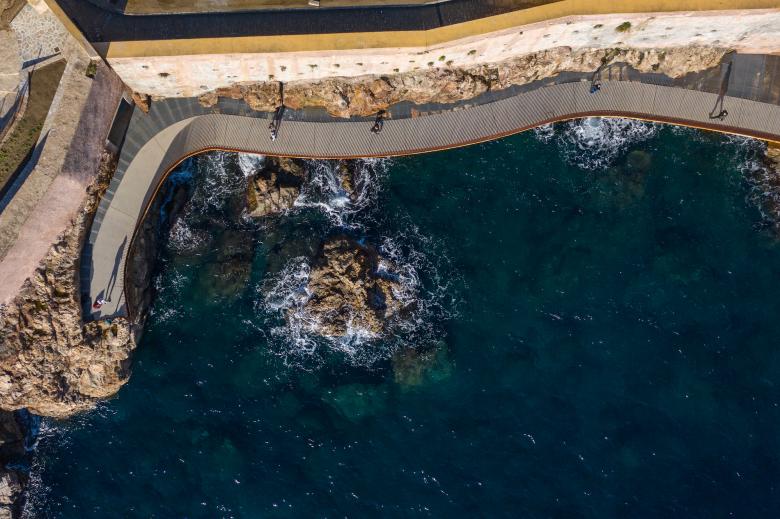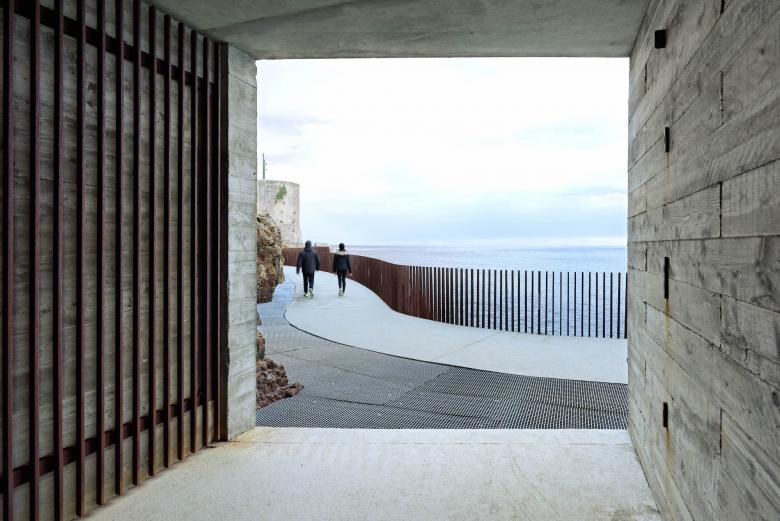Suspended Between Sea and Sky
The new pedestrian promenade in Bastia, France, is a masterpiece of urban design and engineering. Designed by Dietmar Feichtinger Architectes, the corniche follows the rocky coastline of the Mediterranean Sea below the Corsican city. Ulf Meyer recently visited the path that has become a destination in and of itself.
Bastia, one of two major cities on the French Mediterranean island of Corsica, was designed as a fortress. Towards the Tyrrhenian Sea it shows a powerful fortification with an impressive geometry that cuts off the city from the sea. Since there is no longer the need to defend Corsican cities against the Genoese or the French mainlanders (although some locals would argue otherwise!), opportunity arose to completely turn the city around and “open” itself towards the Mediterranean. With regards to the natural rock on which Bastia stands, this is easier said than done. Nevertheless, the goal was reached, when the new €10 million corniche was completed last year. The new “Aldilonda – Promenade over the Sea” — 450 meters long but only three meters wide — manages to reorient Bastia while being an engineering marvel at the same time.
There is no better architecture and engineering firm in Europe for such a delicate task, one that requires an understanding of urban infrastructure but also elegance in engineering, than Dietmar Feichtinger Architectes from Paris. Feichtinger studied architecture in Graz, moved to Paris in 1989, and then founded his firm five years later. Before Bastia, the Austrian architect had already proven he could think and design on several levels simultaneously, having designed the Passerelle Simone-de-Beauvoir in Paris and the Jetty to Mont-Saint-Michel — just two of his most successful reference projects.
In Bastia, Feichtinger’s intervention is called “Aldilonda” (it translates to “above the water” in the Corsican language) and is a hybrid between a horizontal coastline walkway that offers great views of the wild sea and a new vertical connector between the Terra Nova, or high city, with new stairs and elevators. Feichtnger chose a design approach that contrasts nature and architecture. It is not intended to be “organic,” but the roughness of the Corten steel and rammed concrete fits the geometry of the imposing stone reliefs and cliffs that are crowned by a citadel from the 14th century dominated by the tower of the Cathedral of Saint Marie.
“Habit kills creativity,” says Feichtinger, who likes to treat every project as a new one, avoiding routine. Feichtinger fits his projects into their settings and pays close attention to structure. “The bones of a building are what every architect should be interested in,” he states. His design for Bastia conceals nothing in front of the spectacular coastline and the city's historic walls. From the Porto Vecchio in the south, the new promenade architecturale continues under the walls of the former powder magazine. The link is mainly a pedestrian path, popular with joggers, but also accessible to people with reduced mobility and thus to cyclists. Still, the gentle route with its panoramic views works best for a walk with an apéritif in the evening sun or a digestive stroll after a meal and sunset. Feichtinger worked LED lights into the Corten steel posts that illuminate the path after dark at three-meter intervals. During the day a light shaft that was cut into the mass of the bastion and a staircase give access to the terrace and improve orientation and daylighting. Local youngsters test their courage when jumping the walls and cliffs to dive into the water.
The longer part of the boardwalk had to be anchored in the rock and construction logistics must have been a headache. How to pour concrete from boats rocked by waves? The local design and construction companies involved in the project found clever ways to overcome these hurdles for constructing the concrete path suspended five meters above the rough water. The terrazzo floor in ochre (warm and soft to bare feet) and the rusty shades of the railing (the rust continuing down the slab lengthens these vertical lines) add some welcome patina and match the color of the quartzite rocks, plaster and stone facades of the buildings above. The guardrail is made up of only vertical posts (2cm thick Corten steel bars) without any horizontal handrails — a clever detail that visually frees views towards the horizon. When moving, visitors experience an interesting moiré effect.
Some sections of the concrete slab were poured directly on the rock, while others cantilever over the sea. Some 23 prefabricated concrete brackets were embedded deep in the rock by means of prestressed anchors, some of them as long as 24 meters. During construction, soundings revealed cavities in the wall, and so tricky reinforcements of the rock were necessary. The consoles support a concrete deck made up of 18 prefab caissons. The profile was calculated to resist the impacts of a hundred-year wave and to offer resistance to shocks caused by the surf. The V-shaped profile of the deck was moved away from the cliff to allow the wave to pass between the rock and the masonry structure, another clever detail that makes sense both functionally and aesthetically. A concrete slab was poured atop the decks, but the residual space, of variable width, that remains between the curving concrete path and the irregular profile of the rocks was filled with a permeable steel grating.
Feichtinger’s “Aldilonda” reunites the city of Bastia with the Mediterranean Sea and offers a fresh look at the city, through a whole sequence of attractive new perspectives. This is no small feat for a relatively discrete intervention.












